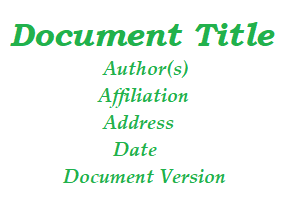Software Requirement Specification (SRS) Format
Last Updated :
20 Sep, 2023
In order to form a good SRS, here you will see some points that can be used and should be considered to form a structure of good Software Requirements Specification (SRS). These are below mentioned in the table of contents and are well explained below.
Software Requirement Specification (SRS) Format as the name suggests, is a complete specification and description of requirements of the software that need to be fulfilled for the successful development of the software system. These requirements can be functional as well as non-functional depending upon the type of requirement. The interaction between different customers and contractors is done because it is necessary to fully understand the needs of customers.  Depending upon information gathered after interaction, SRS is developed which describes requirements of software that may include changes and modifications that is needed to be done to increase quality of product and to satisfy customer’s demand.
Depending upon information gathered after interaction, SRS is developed which describes requirements of software that may include changes and modifications that is needed to be done to increase quality of product and to satisfy customer’s demand.
Introduction
- Purpose of this Document – At first, main aim of why this document is necessary and what’s purpose of document is explained and described.
- Scope of this document – In this, overall working and main objective of document and what value it will provide to customer is described and explained. It also includes a description of development cost and time required.
- Overview – In this, description of product is explained. It’s simply summary or overall review of product.
General description
In this, general functions of product which includes objective of user, a user characteristic, features, benefits, about why its importance is mentioned. It also describes features of user community.
Functional Requirements
In this, possible outcome of software system which includes effects due to operation of program is fully explained. All functional requirements which may include calculations, data processing, etc. are placed in a ranked order. Functional requirements specify the expected behavior of the system-which outputs should be produced from the given inputs. They describe the relationship between the input and output of the system. For each functional requirement, detailed description all the data inputs and their source, the units of measure, and the range of valid inputs must be specified.
Interface Requirements
In this, software interfaces which mean how software program communicates with each other or users either in form of any language, code, or message are fully described and explained. Examples can be shared memory, data streams, etc.
In this, how a software system performs desired functions under specific condition is explained. It also explains required time, required memory, maximum error rate, etc. The performance requirements part of an SRS specifies the performance constraints on the software system. All the requirements relating to the performance characteristics of the system must be clearly specified. There are two types of performance requirements: static and dynamic. Static requirements are those that do not impose constraint on the execution characteristics of the system. Dynamic requirements specify constraints on the execution behaviour of the system.
Design Constraints
In this, constraints which simply means limitation or restriction are specified and explained for design team. Examples may include use of a particular algorithm, hardware and software limitations, etc. There are a number of factors in the client’s environment that may restrict the choices of a designer leading to design constraints such factors include standards that must be followed resource limits, operating environment, reliability and security requirements and policies that may have an impact on the design of the system. An SRS should identify and specify all such constraints.
Non-Functional Attributes
In this, non-functional attributes are explained that are required by software system for better performance. An example may include Security, Portability, Reliability, Reusability, Application compatibility, Data integrity, Scalability capacity, etc.
Preliminary Schedule and Budget
In this, initial version and budget of project plan are explained which include overall time duration required and overall cost required for development of project.
Appendices
In this, additional information like references from where information is gathered, definitions of some specific terms, acronyms, abbreviations, etc. are given and explained.
Uses of SRS document
- Development team require it for developing product according to the need.
- Test plans are generated by testing group based on the describe external behaviour.
- Maintenance and support staff need it to understand what the software product is supposed to do.
- Project manager base their plans and estimates of schedule, effort and resources on it.
- customer rely on it to know that product they can expect.
- As a contract between developer and customer.
- in documentation purpose.
1. Why is it important to define the scope of an SRS document?
Defining the scope in an SRS document helps the customer understand the goals and worth of the software. It also has details about how much it will cost to create and how long it will take, so that the project’s limits are clear.
2. What are functional requirements in an SRS document, and why are they important?
Functional requirements describe how the software system is supposed to work, including how it should react to inputs and make outputs. They help you figure out what the software needs to do and give you a place to start building and testing it.
Conclusion
Software development requires a well-structured Software Requirement Specification (SRS). It helps stakeholders communicate, provides a roadmap for development teams, guides testers in creating effective test plans, guides maintenance and support employees, informs project management decisions, and sets customer expectations. The SRS document helps ensure that the software meets functional and non-functional requirements, resulting in a quality product on time and within budget.
Share your thoughts in the comments
Please Login to comment...